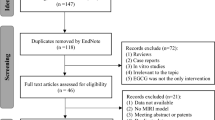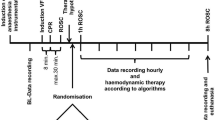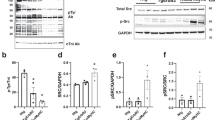Abstract
Aim:
To investigate the effects of epigallocatechin gallate (EGCG) on pressure overload and hydrogen peroxide (H2O2) induced cardiac myocyte apoptosis.
Methods:
Cardiac hypertrophy was established in rats by abdominal aortic constriction. EGCG 25, 50 and 100 mg/kg were administered intragastrically (ig). Cultured newborn rat cardiomyocytes were preincubated with EGCG, and oxida-tive stress injury was induced by H2O2.
Results:
In cardiac hypertrophy induced by AC in rats, relative to the model group, EGCG 25, 50 and 100 mg/kg ig for 6 weeks dose-dependently reduced systolic blood pressure (SBP) and heart weight indices, decreased malondialdehyde (MDA) content, and increased superoxide dismutase (SOD) and glutathione peroxidase (GSH-PX) activity, both in serum and in the myocardium. Also, treatment with EGCG 50 and 100 mg/kg markedly improved cardiac structure and inhibited fibrosis in HE and van Gieson (VG) stain, and reduced apoptotic myocytes in the hypertrophic myocardium detected by terminal transferase-mediated dUTP-biotin nick end-labeling (TUNEL) assay. In the Western blot analysis, EGCG significantly inhibited pressure overload-induced p53 increase and bcl-2 decrease. In H2O2-induced cardiomyocyte injury, when preincubated with myocytes for 6-48 h, EGCG 12.5-200 mg/L increased cell viability determined by 3-(4,5-dimethylthiazol-2-yl)-2,5-diphenyltetrazolium bromide (MTT) assay. EGCG also attenuated H2O2-induced lactate dehydrogenase (LDH) release and MDA formation. Meanwhile, EGCG 50 and 100 mg/L significantly inhibited the cardiomyocyte apoptotic rate in flow cytometry.
Conclusion:
EGCG inhibits cardiac myocyte apoptosis and oxidative stress in pressure overload induced cardiac hypertrophy. Also, EGCG prevented cardiomyocyte apoptosis from oxidative stress in vitro. The mechanism might be related to the inhibitory effects of EGCG on p53 induction and bcl-2 decrease.
Similar content being viewed by others
Log in or create a free account to read this content
Gain free access to this article, as well as selected content from this journal and more on nature.com
or
References
Olivetti G, Cigola E, Maestri R, Lagrasta C, Corradi D, Quaini F . Recent advances in cardiac hypertrophy. Cardiovasc Res 2000; 45: 63–7.
Teiger E, Than VD, Richard L, Wisnewsky C, Tea BS, Gaboury L, et al. Apoptosis in pressure overload induced heart hypertrophy in the rat. J Clin Invest 1996; 97: 2891–7.
Li Z, Bing OH, Long X, Robinson KG, Lakatta EG . Increased cardiomyocyte apoptosis during the transition to heart failure in the spontaneously hypertensive rat. Am J Physiol 1997; 272: H2313–9.
Wencker D, Chandra M, Nguyen K, Miao WF, Garantziotis S, Factor SM, et al. A mechanistic role for cardiac myocyte apoptosis in heart failure. J Clin Invest 2003; 111: 1497–504.
Li PF, Dietz R, Harsdorf RV . p53 regulates mitochondrial membrane potential through reactive oxygen species and induces cytochrome c-independent apoptosis blocked by bcl-2. EMBO J 1999; 21: 6027–36.
Condorelli G, Morisco C, Stassi G, Notte A, Farina F, Sgaramella G . Increased cardiomyocyte apoptosis and changes in proapoptotic and antiapoptotic genes bax and bcl-2 during left ventricular adaptations to chronic pressure overload in the rat. Circulation 1999; 99: 3071–8.
Leri A, Claudio P P, Li Q, Wang X, Reiss K, Wang S, et al. Stretch-mediated release of angiotensin II induces myocyte apoptosis by activating p53 that enhances the local renin-angiotensin system and decreases the bcl-2-to-bax protein ratio in the cell. J Clin Invest 1998; 101: 1326–42.
Cesselli D, Jakoniuk I, Barlucchi L, Beltrami AP, Hintze TH, Nadal-Ginard B, et al. Oxidative stress-mediated cardiac cell death is a major determinant of ventricular dysfunction and failure in dog dilated cardiomyopathy. Circ Res 2001; 89: 279–86.
Chen QM, Tu VC, Wu Y, Bahl JJ . Hydrogen peroxide dose dependent induction of cell death or hypertrophy in cardiomyocytes. Anch Biochem Biophys 2000; 373: 242–8.
Nakamura K, Fushimi K, Kouchi H, Mihara K, Miyazaki M, Ohe T, et al. Inhibitory effects of antioxidants on neonatal rat cardiac myocyte hypertrophy induced by tumor necrosis factor-alpha and angiotensin II. Circulation 1998; 98: 794–9.
Tsujimoto I, Hikoso S, Yamaguchi O, Kashiwase K, Nakai A, Takeda T, et al. The antioxidant edaravone attenuates pressure overload-induced left ventricular hypertrophy. Hypertension 2005; 45: 921–6.
Higdon J V, Frei B . Tea catechins and polyphenols: health effects, metabolism, and antioxidant functions. Crit Rev Food Sci Nutr 2003; 43: 89–143.
Chyu KY, Babbidge SM, Zhao X, Dandillaya R, Rietveld AG, Yano J, et al. Differential effects of green tea-derived catechin on developing versus established atherosclerosis in apolipoprotein E-null mice. Circulation 2004; 109: 2448–53.
Priyadarshi S, Valentine B, Han C, Fedorova O V, Bagrov AY, Liu J, et al. Effect of green tea extract on cardiac hypertrophy following 5/6 nephrectomy in the rat. Kidney Int 2003; 63: 1785–90.
Townsend PA, Scarabelli TM, Pasini E, Gitti G, Menegazzi M . Suzuki H, et al. Epigallocatechin-3-gallate inhibits STAT-1 activation and protects cardiac myocytes from ischemia/reperfusion-induced apoptosis. FASEB J 2004; 18: 1621–3.
Sheng R, Gu ZL, Xie ML, Guo CY, Zhou WX . EGCG inhibits collagen accumulation and cell proliferation in cardiac hypertrophy. Chin Pharmacol Bull 2006; 22: 1095–9.
Li HL, Huang Y, Zhang CN, Liu G, Wei YS, Wang AB, et al. Epigallocathechin-3 gallate inhibits cardiac hypertrophy through blocking reactive oxidative species-dependent and -independent signal pathways. Free Rad Biol Med 2006; 40: 1756–75.
Rice-Evans, C . Implications of the mechanisms of action of tea polyphenols as antioxidants in vitro for chemoprevention in humans. Proc Soc Exp Biol Med 1999; 220: 262–6.
Shimoyama M, Hayashi D, Takimoto E, Zou YZ, Oka T, Uozumi H, et al. Calcineurin plays a critical role in pressure overload- induced cardiac hypertrophy. Circulation 1999; 100: 2449–54.
Li JL, Li P, Feng XH, Li ZP, Hou R, Han C, et al. Effects of lorsartan on pressure overload-induced cardiac gene expression profiling in rats. Clin Exp Pharmacol Physiol 2003; 30: 827–32.
Yamamoto, M, Yang G P, Hong C, Liu J, Holle E, Yu XZ, et al. Inhibition of endogenous thioredoxin in the heart increases oxidative stress and cardiac hypertrophy. J Clin Invest 2003; 112: 1395–406.
Baldi A, Abbate A, Bussani R, Melfi GR, Angelini A, Dobrina A, et al. Apoptosis and post-infarction left ventricular remodeling. J Mol Cell Cardiol 2002; 34: 165–74.
Ji ES, Yue H, Wu YM, He RR . Effects of phytoestrogen genistein on myocardial ischemia/reperfusion injury and apoptosis in rabbits. Acta Pharmacol Sin 2004; 25: 306–12.
Cao Y, Gu ZL, Lin F, Han R, Qin ZH . Caspase-1 inhibitor Ac-YVAD-CHO attenuates quinolinic acid-induced increases in p53 and apoptosis in rat striatum. Acta Pharmacol Sin 2005; 26: 150–4.
Aikawa R, Nawano M, Gu Y P, Katagiri H, Asano T, Zhu WD, et al. Insulin prevents cardiomyocytes from oxidative stress–induced apoptosis through activation of pI3 Kinase/Akt. Circulation 2000; 102: 2873–9.
Akao M, Ohler A, O'Rourke B, Marban E . Mitochondrial ATP-sensitive potassium channels inhibit apoptosis induced by oxidative stress in cardiac cells. Circ Res 2001; 88: 1267–75.
Zhang RL, Pinson A, Samuni A . Both hydroxylamine and nitroxide protect cardiomyocytes from oxidative stress. Free Rad Biol Med 1998; 24: 66–75.
Sawyer DB, Fukazawa R, Arstall MA, Kelly RA . Daunorubicin-induced apoptosis in rat cardiac myocytes is inhibited by dexrazoxane. Circ Res 1999; 84: 257–65.
Chow SH-H, Cai Y, Hakim IA, Crowell JA, Shahi F, Brooks CA, et al. Pharmacokinetics and safety of green tea polyphenols after multiple-dose administration of epigallocatechin gallate and polyphenon E in healthy individuals. Clin Caner Res 2003; 9: 3312–9.
Hong Y, Hui SSC, Chan BTY, Hou JY . Effect of berberine on catecholamine levels in rats with experimental cardiac hypertrophy. Life Sci 2003; 72: 2499–507.
Harsdorf RV, Li PF, Dietz R . Signaling pathways in reactive oxygen species-induced cardiomyocyte apoptosis. Circulation 1999; 99: 2934–41.
Leri A, Liu Y, Malhotra A, Li Q, Stiegler P, Claudio PP, et al. Paing-induced heart failure in dogs enhances the expression of p53 and p53–dependent genes in ventricular myocytes. Circulation 1998; 97: 194–203.
Leri A, Fiordaliso F, Setoguchi M, Limana F, Bishopric NH, Kajstura J, et al. Inhibition of p53 function prevents rennin-angiotensin system activation and stretch-mediated myocyte apoptosis. Am J Pathol 2000; 157: 843–57.
Johnson TM, Yu ZX, Ferrans VJ, Lowenstein RA, Finkel T . Reactive oxygen species are downstream mediators of p53-depen-dent apoptosis. Proc Natl Acad Sci USA 1996; 93: 11848–52.
Author information
Authors and Affiliations
Corresponding authors
Additional information
Project supported by the Hong Kong Association for Health Care Ltd research subject (No HK200208).
Rights and permissions
About this article
Cite this article
Sheng, R., Gu, Zl., Xie, Ml. et al. EGCG inhibits cardiomyocyte apoptosis in pressure overload-induced cardiac hypertrophy and protects cardiomyocytes from oxidative stress in rats. Acta Pharmacol Sin 28, 191–201 (2007). https://doi.org/10.1111/j.1745-7254.2007.00495.x
Received:
Accepted:
Issue date:
DOI: https://doi.org/10.1111/j.1745-7254.2007.00495.x
Keywords
This article is cited by
-
Consumption of green tea epigallocatechin-3-gallate enhances systemic immune response, antioxidative capacity and HPA axis functions in aged male swiss albino mice
Biogerontology (2017)
-
(−)-Epigallocatechin-gallate (EGCG) stabilize the mitochondrial enzymes and inhibits the apoptosis in cigarette smoke-induced myocardial dysfunction in rats
Molecular Biology Reports (2013)
-
Reduction of Rat Cardiac Hypertrophy by Osthol is Related to Regulation of Cardiac Oxidative Stress and Lipid Metabolism
Lipids (2012)



